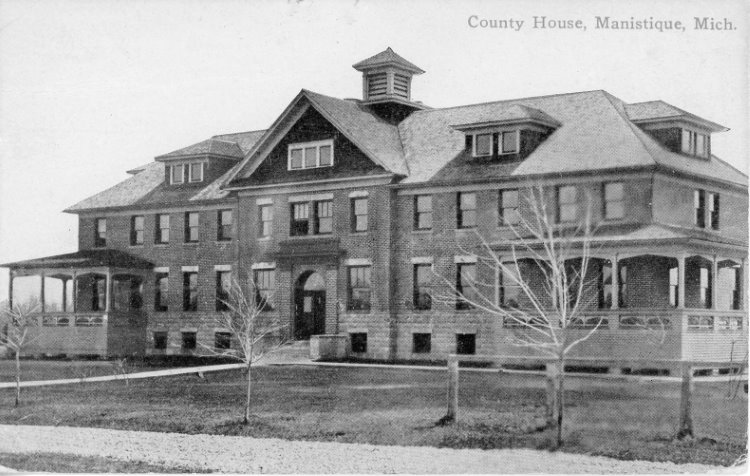
The new Schoolcraft County Poor House pictured here in 1909. SCHS photo
Prior to 1891 the poor, who could not care for themselves, were totally dependent upon the kind heartedness of relatives or neighbors. That situation changed in 1892, when Schoolcraft County erected a small one-story frame building on Manistique’s west side for the care of the indigent. The home provided separate quarters for men and women, with tubs for bathing and “a good supply of water.” It lacked sewage and was poorly ventilated. Despite the home’s shortcomings, an inspector from the Michigan State Board of Corrections and Charities reported that “all was in good clean condition.” Hospital services were provided in another smaller building on the poor house grounds, with the sick being cared for by local physicians.
The local County Superintendent of the Poor reported that the “paupers were treated kindly, but with decision.” Meals were furnished three times daily and were of good quality and ample quantity. Clothing was issued to the residents as needed. The poor house was not staffed or equipped to provide services for persons who were mentally ill or developmentally disabled. There were also no accommodations for children.
The residents of the poor house were primarily men who were elderly, sick or crippled and had no family to care for them. The vast majority were immigrants. Homeless men, referred to as “tramps,” also found food and shelter in the poor house. A county farm was operated to supply the poor house with fresh fruits and vegetables. The poor who were physically able provided some of the labor on the farm.
Death records for the year 1894 are illuminating regarding the type of population served at the poor house in those early years. Five deaths took place at the home in 1894, all of them men. These included two single men, ages 25 and 28. One of the men died of consumption (tuberculosis) and the other of chronic diarrhea. A widower, age 88, died from complications of old age while another man, age 57, was found accidentally frozen on the poor house grounds. A fifth man, a 42 year old widower, succumbed from dropsy and syphilis.
As Manistique’s population grew rapidly during the 1890’s and early 1900’s, the numbers of poor needing assistance with food, clothing, shelter and medical care also increased dramatically. In 1907, the county responded to the need by erecting a new two story brick building on West Elk Street. Opening in February of 1908, the new county house was a vast improvement over the former building, with the capacity to serve up to 50 residents. The building was lighted by electricity and heated with steam. Toilet facilities were of a “good grade” and the building was well ventilated. The State Board of Charities encouraged county homes to be more than just a place to provide bed and board for the poor, but also strive to become “a home and hospital for the dependent and sick.” In an effort to lessen the stigma to resident’s staying at these facilities, county homes were now officially referred to as infirmaries.

The Schoolcraft County Infirmary circa 1915. SCHS Photo
Pastors from the various congregations conducted worship services at the county house on a rotating monthly schedule. During the 1920’s it became a tradition for the members of the Poor Commission to treat the Board of Supervisors to dinner at the home prior to their annual inspection of the facility. The county continued to operate a farm to help supply the infirmary with fresh vegetables. In 1929, the county farm began raising hogs as a way to dispose of the homes left over food while eventually providing meat for the infirmary kitchen.
The home continued to serve the county’s impoverished population through the early 1940’s. Overcrowding remained an issue in the men’s half of the building while the women’s quarters remained nearly empty. The home ceased operations as an infirmary in January of 1943 with the majority of the residents being transferred to other facilities. The county welfare office was located there in the mid 1940’s and two rooms were also set aside for the detention of juveniles who had been remanded to court custody.
The building housed the Cloverland Lodge nursing home during the 1950’s and early 60’s before its license was revoked after failing to win approval from the fire marshal. The building was later transformed into an adult foster care home, being known for a time as the Manistique Manor. It is now a private residence.
To learn about the historical society’s new museum fund drive, see the “About Us” page on our website at https/schs.cityofmanistique.org/about-us/. Our mailing address is SCHS, P.O. Box 284, Manistique, MI. 49854 or use the donate button at the top of the page.
